SAPPHIRE BUYING GUIDE
LEARN EVERYTHING YOU NEED TO KNOW ABOUT BUYING YOUR FIRST SAPPHIRE GEMSTONE.
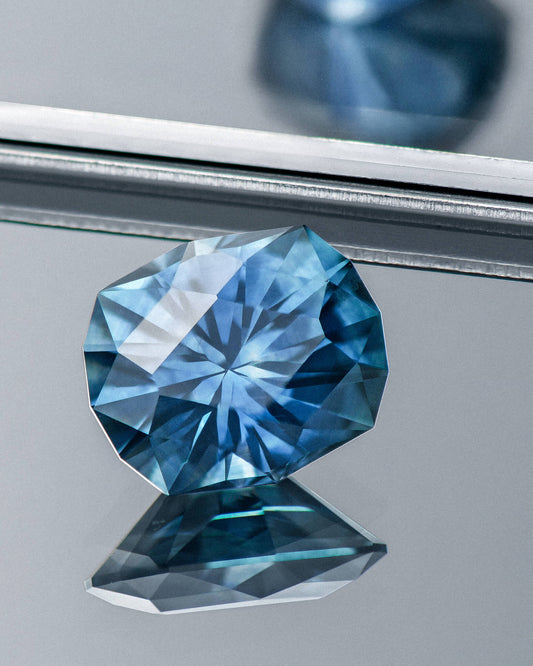
How to choose a sapphire
When it comes to choosing a sapphire, beauty is in the eye of the beholder. However when we are talking about the value of sapphires there are six main factors at play. It is the combination of these factors that determine the value.
01. SAPPHIRE COLOUR
Colour in sapphires is broken into hue, saturation and tone with the greatest value being in hues with vivid saturation and medium tone. Certain hues will command a higher price than others.
02. SAPPHIRE CLARITY
There is no official clarity grading system for sapphires. It is the presence of rutile needles containing elements that give sapphire its colour, so the presence of inclusions within a sapphire is expected. However the inclusions will normally be masked by the colour in the stone and as long as there are no noticeable inclusions to the eye it will not affect the value.
03. SAPPHIRE CUT
Sapphires are cut to maximise their colour. For this reason there can be a lot of variation in cut proportions for sapphires. The cut doesn’t affect the value of a sapphire to the same extent that colour and carat weight do.
04. SAPPHIRE CARAT
The higher the carat weight the more valuable the sapphire. Sapphires above 2 carat are exponentially more rare and more valuable. The spread (or face up size) of a sapphire can vary greatly between sapphires of similar carat weights and shapes.
05. SAPPHIRE TREATMENTS
The majority of natural sapphires will have received heat treatment, which is the accepted industry standard. Heat treatment is essentially a continuation of the heating that occurs inside the earth's mantle via volcanic heat releasing colour into the crystal.
06. SAPPHIRE COUNTRY OF ORIGIN
Another major factor that will play a big role in the value of a sapphire is the commercial demand. There are famous sapphires such as Royal Blue Sapphires and Pigeon Blood Ruby which will command a higher price than more niche colours or regions such as Australian parti sapphires or Nigerian teal sapphires. This will play a bigger role in pricing than whether the sapphire is heated or unheated in the larger sizes.
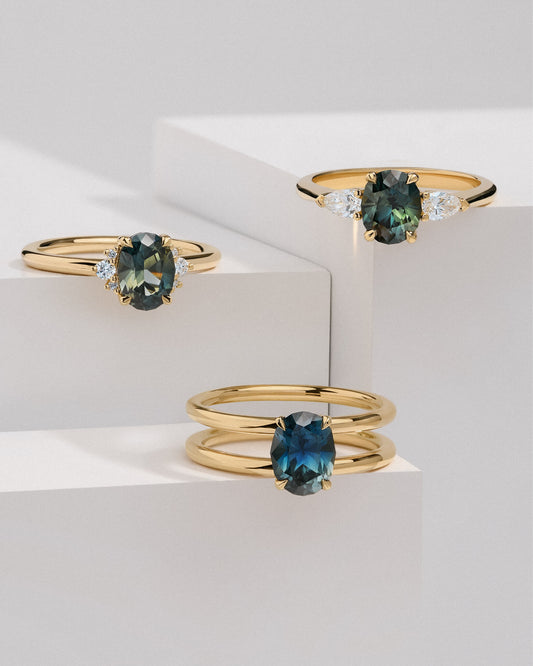
Sapphire Certification
Unlike diamonds it is the exception rather than the rule for sapphires to be certified. Certification is simple and only generally includes the carat weight, colour, if it's natural or synthetic and if it has received any treatment.
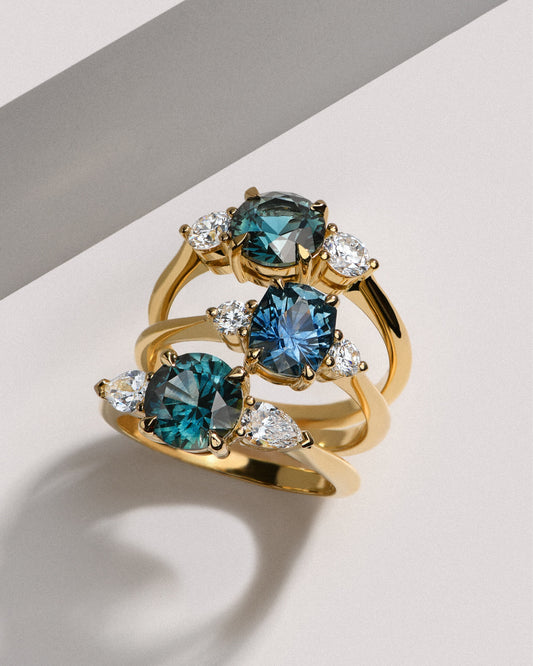
Sapphire Hardness
Sapphires are 9 on the MOH scale of hardness making them a durable gemstone for everyday wear. However it is still possible to chip sapphires so as with all fine jewellery care is to be taken when wearing them. In comparison diamond is 10 on the MOH scale of harness making it the hardest thing on earth. This harness gives diamonds an incomparable luster and sparkle known as “adamantine”. However, it is arguable that sapphire is more durable than diamond due to the fact that diamond has a point of cleavage in its crystal structure which if knocked can make the diamond split clean open.
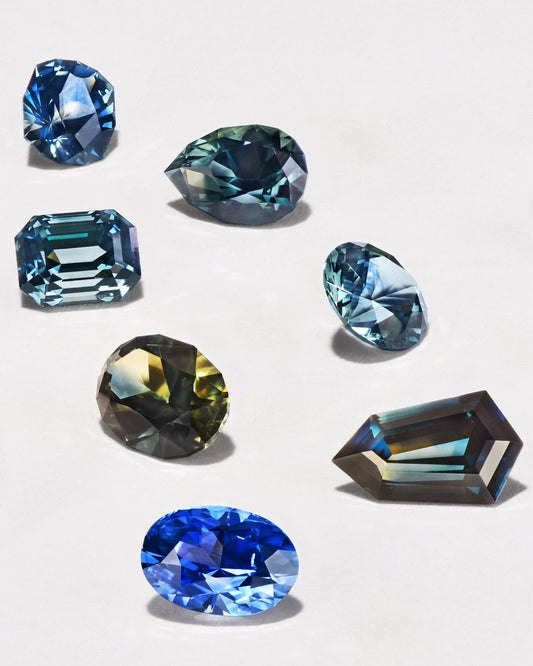
Sapphire Stone Origins & Sourcing
Our sapphires are ethically sourced by our Gemologist Hamish Whiting directly from the regions where they are mined from trusted gemstone cutters and brokers. Our sapphires are mined using small scale artisanal mining methods which are low impact on the environment and provide essential income to the local communities.
SAPPHIRE ENGAGEMENT RINGS
View all-
Maya 1.38ct Round Deep Teal Blue Sapphire Three Stone Engagement Ring
 Maya 1.38ct Round Deep Teal Blue Sapphire Three Stone Engagement Ring
Maya 1.38ct Round Deep Teal Blue Sapphire Three Stone Engagement Ring- Regular price
- $8,300 AUD
- Regular price
-
- Sale price
- $8,300 AUD
- Unit price
- per
Maya 1.38ct Round Deep Teal Blue Sapphire Three Stone Engagement Ring Maya 1.38ct Round Deep Teal Blue Sapphire Three Stone Engagement Ring
Maya 1.38ct Round Deep Teal Blue Sapphire Three Stone Engagement Ring- Regular price
- $8,300 AUD
- Regular price
-
- Sale price
- $8,300 AUD
- Unit price
- per
-
AVA Sapphire Solitaire Engagement Ring
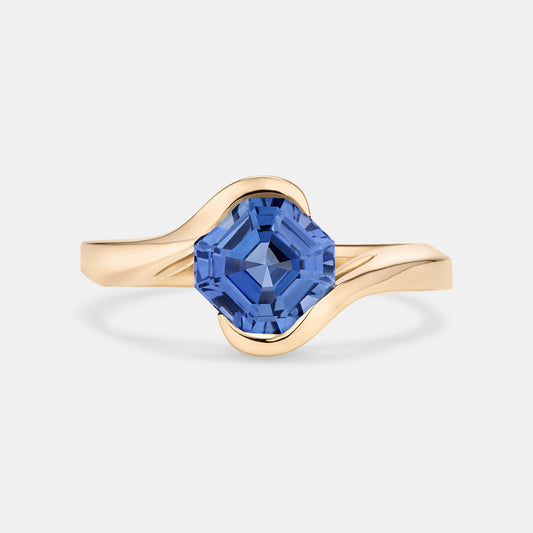 AVA Sapphire Solitaire Engagement Ring
AVA Sapphire Solitaire Engagement Ring- Regular price
- FROM $8,000 AUD
- Regular price
-
- Sale price
- $8,000 AUD
- Unit price
- per
AVA Sapphire Solitaire Engagement Ring AVA Sapphire Solitaire Engagement Ring
AVA Sapphire Solitaire Engagement Ring- Regular price
- FROM $8,000 AUD
- Regular price
-
- Sale price
- $8,000 AUD
- Unit price
- per
-
AMELIA 3.87ct Radiant Cut Australian Sapphire Five Stone Engagement Ring
 AMELIA 3.87ct Radiant Cut Australian Sapphire Five Stone Engagement Ring
AMELIA 3.87ct Radiant Cut Australian Sapphire Five Stone Engagement Ring- Regular price
- $18,900 AUD
- Regular price
-
- Sale price
- $18,900 AUD
- Unit price
- per
AMELIA 3.87ct Radiant Cut Australian Sapphire Five Stone Engagement Ring AMELIA 3.87ct Radiant Cut Australian Sapphire Five Stone Engagement Ring
AMELIA 3.87ct Radiant Cut Australian Sapphire Five Stone Engagement Ring- Regular price
- $18,900 AUD
- Regular price
-
- Sale price
- $18,900 AUD
- Unit price
- per
-
Maya 1.90ct Round Australian Sapphire Three Stone Engagement Ring
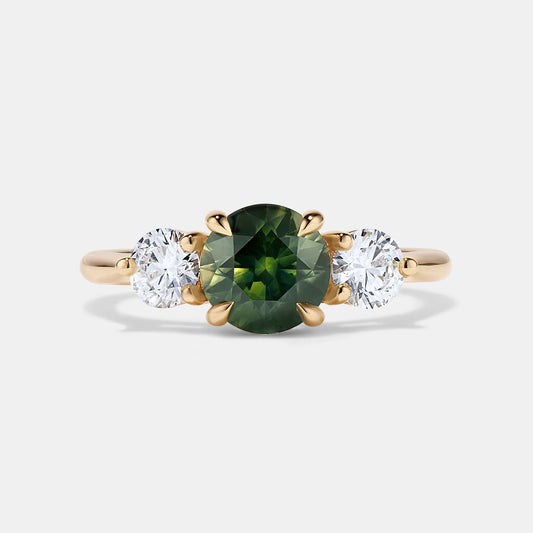 Maya 1.90ct Round Australian Sapphire Three Stone Engagement Ring
Maya 1.90ct Round Australian Sapphire Three Stone Engagement Ring- Regular price
- $8,600 AUD
- Regular price
-
- Sale price
- $8,600 AUD
- Unit price
- per
Maya 1.90ct Round Australian Sapphire Three Stone Engagement Ring Maya 1.90ct Round Australian Sapphire Three Stone Engagement Ring
Maya 1.90ct Round Australian Sapphire Three Stone Engagement Ring- Regular price
- $8,600 AUD
- Regular price
-
- Sale price
- $8,600 AUD
- Unit price
- per
-
Amelia 2.72ct Emerald Cut Australian Sapphire Five Stone Engagement Ring
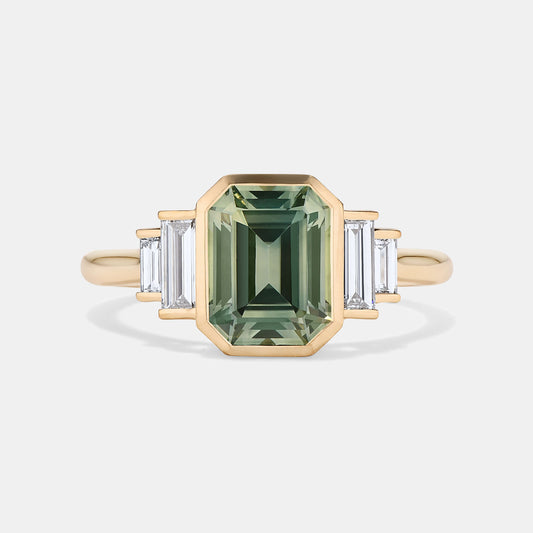 Amelia 2.72ct Emerald Cut Australian Sapphire Five Stone Engagement Ring
Amelia 2.72ct Emerald Cut Australian Sapphire Five Stone Engagement Ring- Regular price
- $16,900 AUD
- Regular price
-
- Sale price
- $16,900 AUD
- Unit price
- per
Amelia 2.72ct Emerald Cut Australian Sapphire Five Stone Engagement Ring Amelia 2.72ct Emerald Cut Australian Sapphire Five Stone Engagement Ring
Amelia 2.72ct Emerald Cut Australian Sapphire Five Stone Engagement Ring- Regular price
- $16,900 AUD
- Regular price
-
- Sale price
- $16,900 AUD
- Unit price
- per
-
Selene 0.90ct Shield Mixed Cut Sapphire Solitaire Engagement Ring
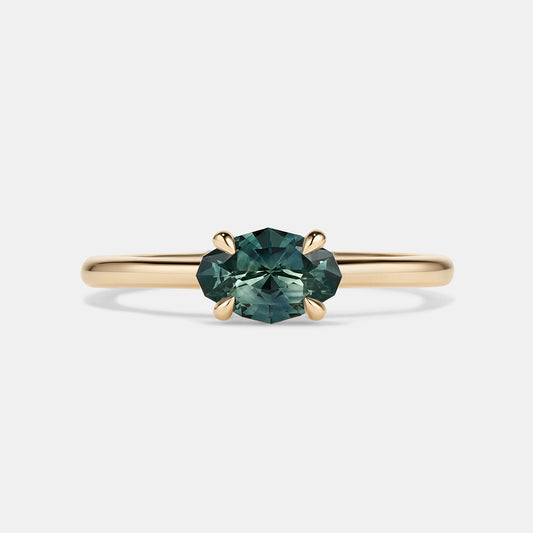 Selene 0.90ct Shield Mixed Cut Sapphire Solitaire Engagement Ring
Selene 0.90ct Shield Mixed Cut Sapphire Solitaire Engagement Ring- Regular price
- $5,400 AUD
- Regular price
-
- Sale price
- $5,400 AUD
- Unit price
- per
Selene 0.90ct Shield Mixed Cut Sapphire Solitaire Engagement Ring Selene 0.90ct Shield Mixed Cut Sapphire Solitaire Engagement Ring
Selene 0.90ct Shield Mixed Cut Sapphire Solitaire Engagement Ring- Regular price
- $5,400 AUD
- Regular price
-
- Sale price
- $5,400 AUD
- Unit price
- per
-
Aegis 1.70ct Shield Step Cut Teal Sapphire Solitaire Engagement Ring
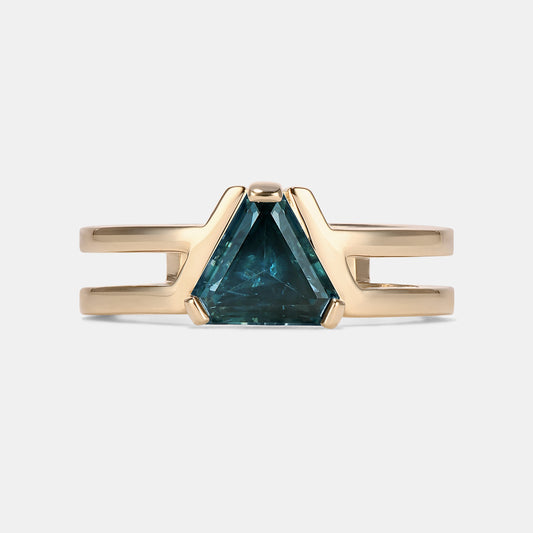 Aegis 1.70ct Shield Step Cut Teal Sapphire Solitaire Engagement Ring
Aegis 1.70ct Shield Step Cut Teal Sapphire Solitaire Engagement Ring- Regular price
- $8,800 AUD
- Regular price
-
- Sale price
- $8,800 AUD
- Unit price
- per
Aegis 1.70ct Shield Step Cut Teal Sapphire Solitaire Engagement Ring Aegis 1.70ct Shield Step Cut Teal Sapphire Solitaire Engagement Ring
Aegis 1.70ct Shield Step Cut Teal Sapphire Solitaire Engagement Ring- Regular price
- $8,800 AUD
- Regular price
-
- Sale price
- $8,800 AUD
- Unit price
- per
-
Barbara 1.36ct Emerald Cut Sapphire Three Stone Engagement Ring
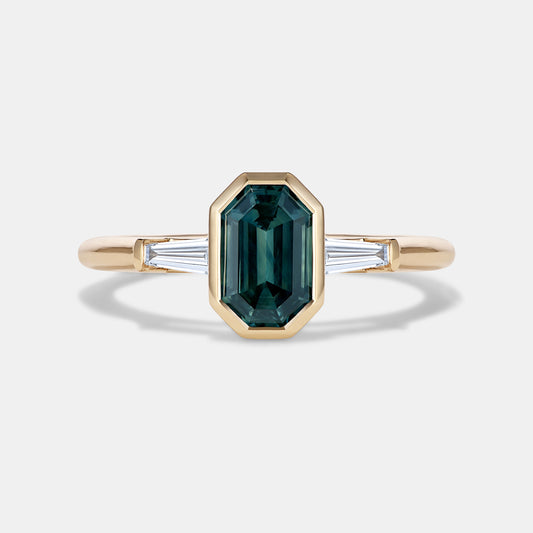 Barbara 1.36ct Emerald Cut Sapphire Three Stone Engagement Ring
Barbara 1.36ct Emerald Cut Sapphire Three Stone Engagement Ring- Regular price
- $8,500 AUD
- Regular price
-
- Sale price
- $8,500 AUD
- Unit price
- per
Barbara 1.36ct Emerald Cut Sapphire Three Stone Engagement Ring Barbara 1.36ct Emerald Cut Sapphire Three Stone Engagement Ring
Barbara 1.36ct Emerald Cut Sapphire Three Stone Engagement Ring- Regular price
- $8,500 AUD
- Regular price
-
- Sale price
- $8,500 AUD
- Unit price
- per
SAPPHIRE FAQs
Generally sapphires are less expensive than diamonds unless they are a particularly famous and desired type of sapphire e.g. Burmese Ruby, Padparascha sapphire, Royal blue sapphire.
Our sapphires are all ethically sourced from the regions that they are artisanally mined or cut. This includes Australia, Montana, Nigeria, Madagascar and Sri Lanka.
Sapphire is corundum crystal which is made of aluminium oxide. The colour of the corundum is determined by the presence of natural elements that exist within the sapphire when it is forming e.g titanium and iron. It is the elements reacting with volcanic or man made heat that cause the colour in sapphire.







